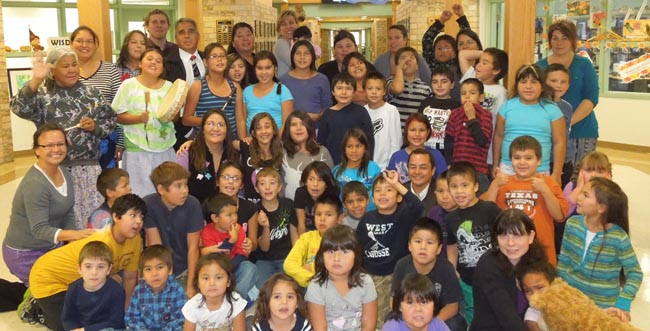Rolling the dice on our education

An open letter about why the First Nations Education Act harms First Nations
By Chief Shining Turtle, Whitefish River First Nation
Aanii, hello, to all my Aboriginal and non-Aboriginal relations. Greetings to you from your neighbours at Whitefish River First Nation.
Do you have children? I do. Thinking about my children’s future, and the future of other kids in my community is what motivates me to get out into the world and work hard for my community.
One of my biggest joys in life is watching my kids grow and learn. This winter, my four-year-old daughter took to the ice in her first-ever hockey tournament. She was eager to learn, fiercely determined to win, and proud of playing for Whitefish River First Nation. I thought my heart would explode with pride and joy, watching her develop exciting new skills and seeing her represent our community.
Our kids are our destiny. I look at them and I know that our children hold the future of our communities in their hands. Harm our children, and you damage the very heart of our people and our culture.
That is why I care so much about the federal government’s proposed changes for First Nations education. Proper education is key to the future of our children and our communities.
I know that many Canadians are confused about why First Nation communities are reacting so passionately about Bill C-33, the federal government’s so-called First Nations Control of First Nations Education Act. I would like to help others understand, by explaining why I am opposed to it.
First of all, it doesn’t help that the name of the Act is completely misleading. The federal government wants you to believe that the proposed Act promotes First Nations control of First Nations education. But, in fact, it does nothing of the sort. It does in fact do the opposite.
There is not a single thing that the proposed Act “allows” First Nations to do that we don’t already do. It does not advance First Nations control. In fact, it would significantly set back that control by making everything we do subject to unpredictable federal approval by a Ministry that has zero expertise in education.
Instead of building the capacity of First Nations institutions, Bill C-33 would require an army of federal bureaucrats in the department of Aboriginal Affairs – which hasn’t governed First Nations education since residential schools. It would actually dramatically increase federal control of First Nations education, but taking power away from First Nations governments and centralizing that power in federal hands.
The proposed legislation creates new federal rules, federal regulations, and numerous discretionary decisions, left at the whim of the federal Minister of Aboriginal Affairs. All of this is backed up by a new federal enforcement regime, which would also be deployed at the Minister’s say-so.
It’s a recipe for chaos, not for success.
Yes, you can understand Bill C-33 on its face if you read past the title, and it’s not a pretty face. But it’s probably best to understand Bill C-33 with a bit of context.
I want to make sure the children of my community have an outstanding education that prepares them to be both strong Anishinaabe citizens and strong Canadian citizens. That will require more resources that we’ve had to date (and more than the federal government recently announced), but I have no hesitation in saying that resources alone are not enough. It also requires clear standards, planning to measure and improve our achievement, supportive institutions that assist each school and classroom, and full accountability to our students and parents.
I’m not alone in supporting more standards and accountability. For example, my own First Nation has been working with 38 others to design an Anishinabek Education System that includes all of the above – under First Nations control, not federal control. We have been at a negotiation table with the federal government for years to implement those efforts. Many other First Nations are involved in similar initiatives of their own.
Setting standards and building accountable institutions are essential to any successful education system. The question is: Whose standards and whose institutions?
I know with every fibre of my being that the answer is with First Nations and the honourable negotiation of agreements, not with the federal department of Aboriginal Affairs. The paternalistic era of “the Minister knows best” should have been closed with residential schools. For the sake of our children, we’re not going back.
In twenty-five years, I want my children to be able to look back and say, “I remember when my father and other First Nations leaders stood up and fought to make sure I had a good education”. I want them to be proud, smart Anishinaabe people, whose wisdom and leadership benefits their own First Nation as well as Canadian society as a whole. I want a better First Nations Education Act for them, one that gets us closer to the goal of a better future for our communities and not further away. If you have kids, put yourself in my shoes: wouldn’t you want the same thing?
In a spirit of friendship and the hope for a good future for all our children,
Whitefish River First Nation
Chief Shining Turtle, Sturgeon Clan, Ojibway Nation


